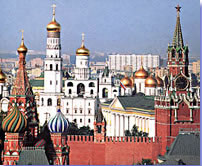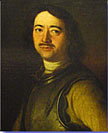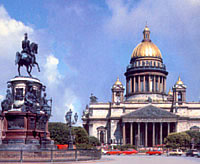Welcome to Russian Language School PRIVET!
Fully concentrating on providing Russian language courses for non-Russian speaking persons, we want the visitors of our site to be able to get some information on the Russian language. On this site you will find useful general information on the Russian language and the Russian alphabet. Besides, you can have a look at or download Phrase Book that would help you in your first days in Russia if you come with just some basic knowledge of Russian language or no knowledge at all. Please serve yourself with our page with useful links with links to some Russian language resources that are worth to have a look at.
Quick Reference
| Official Language: | ex-Soviet Union nations (214 millions) |
| Common 2nd language of: | West Europe and USA (6 million speakers) |
| Number of speakers: | 220 millions (approx) |
| Origin: | Eastern Slavic language developed from migration of some Slavs eastward after 7th Century BC |
| Alphabet & Scripts: | Cyrillic. Alphabet dating from 9th Century AD devised by 2 Greek missionaries (eastern Slavs largely adopted Greek orthodox religion) |
History of the Russian Language

With the collapse of the Union of Soviet Socialist Republics or Soviet Union as it was more often called in 1991, fourteen independent Republics were formed. Russia, or the Russian Federation to give it its full title, covers the majority of the land mass of the former USSR.
All the Republics retain Russian as one of their official languages, alongside the local languages.
The sixth century AD saw the migration of the Slav people from old Poland. The Slavs expanded westwards to the river Elbe and southwards to the Adriatic Sea. Here they gradually occupied much of the Balkans. By the tenth century, three Slavonic language groups had emerged, Western, Southern and Eastern.
Eastern Slavonic gave rise to the modern languages known as Ukrainian, Belorussian and Russian. The Slavonic languages retained many features in common especially in grammatical structure, therefore the separate groups were able to use one common written language. This language was known as Old Slavonic or Old Church Slavonic (the language was used in its written form only).

In the ninth century, two missionaries - Constantine (who on his deathbed took the monastic name Cyril) and Methodius - were required to write down the scriptures in Old Church Slavonic and to preach Christianity to the people of Moravia. Before they set out for Moravia, Constantine invented a Slavonic (now known as the Cyrillic) alphabet. The results of their work contributed greatly to the cultural history of the whole Slav world.
In Russia, Old Church Slavonic remained the written language until the middle of the eighteenth century. By this time, the need was felt for a written language which was closer to the educated spoken norm. One Russian polymath M V Lomonosov asserted that there should be three styles;
- High Style - Church Slavonic, to be used for poetics and religion;
- Middle Style - to be used for lyric poetry, prose and science;
- Low Style - to be used in personal correspondence and in low comedy.
The Middle Style, which combined features of both East Slavonic and Church Slavonic is the style which came to form the basis of the modern standard language. In the mid 1800's, Standard Russian based on the Moscow dialect became the official language.
Today Russian is the most important of the Slavic languages and is now one of the major languages of the world. It is also one of the official languages of the United Nations. In a recent census, 153 million people listed Russian as their mother tongue and another 61 million indicated they spoke it fluently as a second language.
The number of Russian speakers world-wide could be in the region of 220 million. As a result, 10 per cent of the world's population communicate in Slavonic and of these 60 per cent speak Russian.
Russian is written in the Cyrillic alphabet dating from around the ninth century. Although at first glance it appears quite different, a number of letters are written and pronounced as in English (A, K, M, O, and T). Whereas other letters are written in the Roman alphabet but are pronounced differently, i.e. Y/y is pronounced 'oo' as in food and X/x is pronounced 'ch' as in the Scottish word 'loch'.
Already you are able to pronounce 'муха' meaning fly! Furthermore, Russian has no word for 'the', 'a' or 'an' so the word myxa can mean the fly, a fly or just fly.
The Russian language allows a fascinating way of addressing people to whom you have just been introduced. The person's first name is combined with a modified form of his or her father's first name. If a man's first name is Ivan and his father's first name is also Ivan, you would call him Ivan Ivanovich (Ivan, son of Ivan), and if Ivan had a sister, she would be called Natasha Ivanovna, (Natasha, daughter of Ivan). The -ovich and -ovna suffixes are always appended to the father's first name and not to the mother's.
| Russian speaking countries: | Russia |
| Languages: | Russian |
| Capital: | Moscow |
| Area (sq. km): | 17,075,200 |
| Population: | 146 million |
| Currency: | Ruble |
History of Russia
Russia is the general name for the independent, federal republic in eastern Europe and western and northern Asia officially called the Russian Federation.
In geographical extent Russia is the largest country in the world, spanning two continents and containing more than 100 nationalities.

Early Russian history was dominated by the Slavs until the Mongol invasions of the 13th century. Whilst the invasions themselves were unsuccessful, the aftermath moved control to the Tartars and began a period of economic and population reshaping that saw power move to Moscow. Following the fall of Constantinople in 1453, Moscow became the "third Rome" and it's new rulers first began to style themselves "Tsar" (from Caesar).
After periods of civil strife and even anarchy, expansion followed under the Romanovs and first Peter and then Catherine the Great.
The growth of the Russian Empire was, however, increasingly punctuated by the growing discontent of the general populace - who bore the brunt of a constant round of foreign wars or invasions coupled with little or no social reform.
This finally came to a head in the Revolution of 1905 and the Bolshevik takeover under Lenin that followed in 1917.

From 1922 until December 25, 1991, the Russian Federation formed the dominating part of the Union of Soviet Socialist Republics (USSR; or Soviet Union).
The end of the USSR saw the beginning of an ongoing period of dramatic change - economically, socially and militarily.
Most recently, President Putin (who took over following Boris Yeltsin's resignation on December 31st 1999) has strengthened ties with the USA whilst also dealing with continuing problems from break-away republics.
Russia is a member of the UN and is one of the five permanent members of the UN Security Council. It is also a founding member of the Commonwealth of Independent States (CIS), the voluntary association of former Soviet republics that was formed on the dissolution of the USSR.







